Data Handling and Business Intelligence: Current Trends Report
VerifiedAdded on 2023/06/18
|5
|1550
|205
Report
AI Summary
This report provides an overview of data handling within the context of business intelligence, highlighting the roles of data warehousing and data mining. It examines current trends in the field, including cloud adoption, the integration of AI, automation, the importance of data literacy, data storytelling and visualization, natural language processing, self-service BI, data governance, and collaborative insights. The report concludes that business intelligence simplifies decision-making by enabling businesses to understand trends and patterns within large datasets through the use of BI tools. Emerging trends in BI facilitate the understanding of complex data, providing businesses with useful insights for problem-solving and informed decision-making.
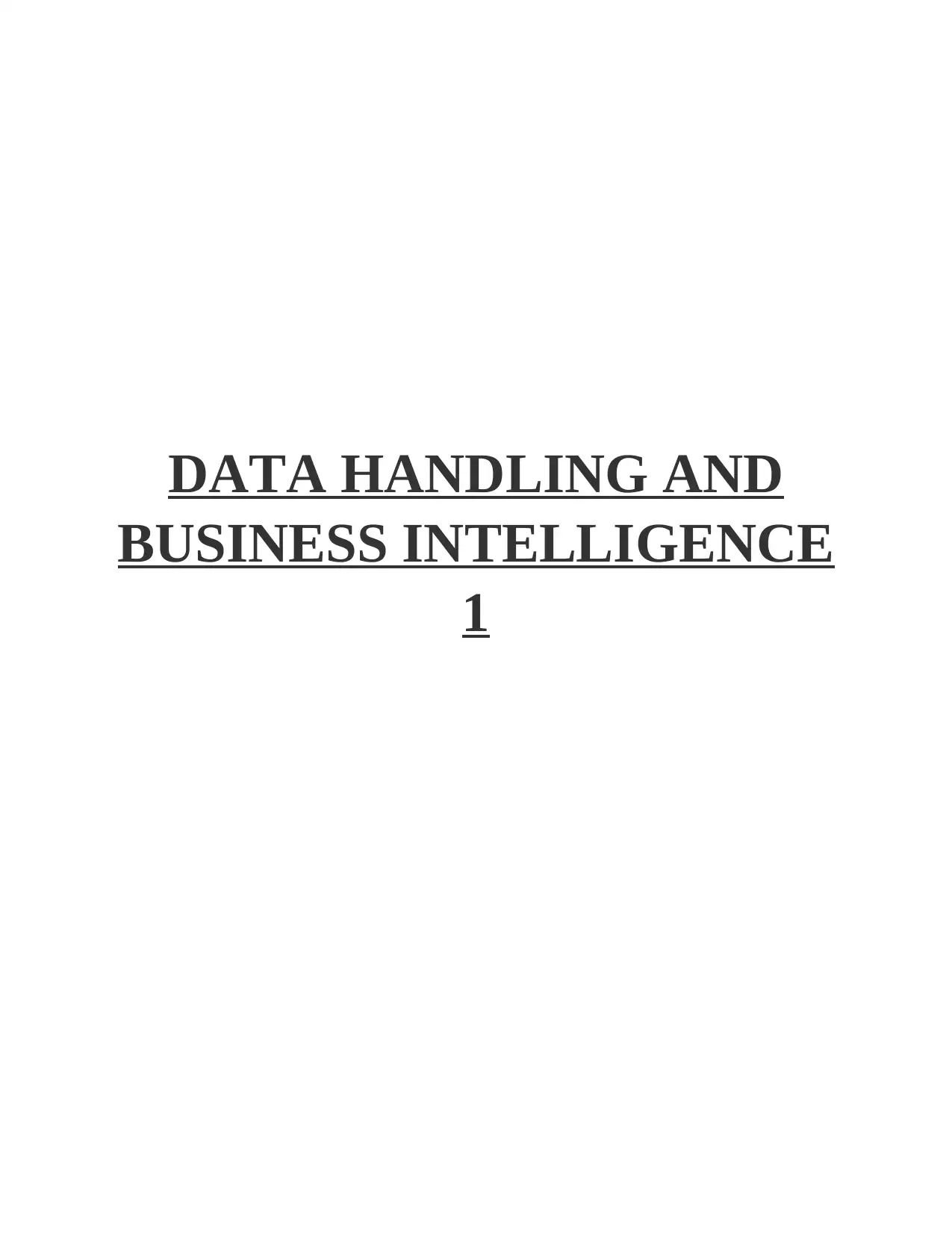
DATA HANDLING AND
BUSINESS INTELLIGENCE
1
BUSINESS INTELLIGENCE
1
Paraphrase This Document
Need a fresh take? Get an instant paraphrase of this document with our AI Paraphraser
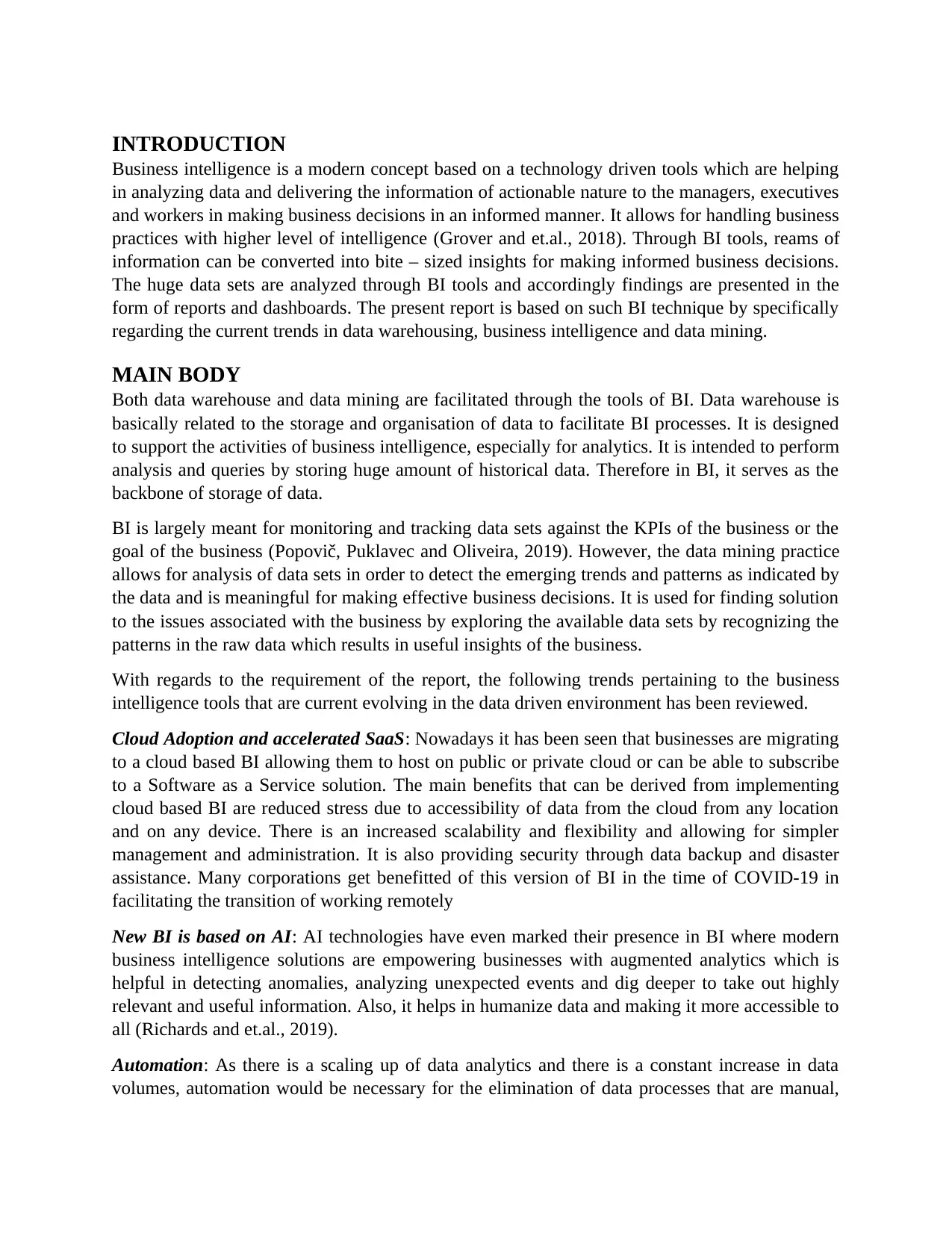
INTRODUCTION
Business intelligence is a modern concept based on a technology driven tools which are helping
in analyzing data and delivering the information of actionable nature to the managers, executives
and workers in making business decisions in an informed manner. It allows for handling business
practices with higher level of intelligence (Grover and et.al., 2018). Through BI tools, reams of
information can be converted into bite – sized insights for making informed business decisions.
The huge data sets are analyzed through BI tools and accordingly findings are presented in the
form of reports and dashboards. The present report is based on such BI technique by specifically
regarding the current trends in data warehousing, business intelligence and data mining.
MAIN BODY
Both data warehouse and data mining are facilitated through the tools of BI. Data warehouse is
basically related to the storage and organisation of data to facilitate BI processes. It is designed
to support the activities of business intelligence, especially for analytics. It is intended to perform
analysis and queries by storing huge amount of historical data. Therefore in BI, it serves as the
backbone of storage of data.
BI is largely meant for monitoring and tracking data sets against the KPIs of the business or the
goal of the business (Popovič, Puklavec and Oliveira, 2019). However, the data mining practice
allows for analysis of data sets in order to detect the emerging trends and patterns as indicated by
the data and is meaningful for making effective business decisions. It is used for finding solution
to the issues associated with the business by exploring the available data sets by recognizing the
patterns in the raw data which results in useful insights of the business.
With regards to the requirement of the report, the following trends pertaining to the business
intelligence tools that are current evolving in the data driven environment has been reviewed.
Cloud Adoption and accelerated SaaS: Nowadays it has been seen that businesses are migrating
to a cloud based BI allowing them to host on public or private cloud or can be able to subscribe
to a Software as a Service solution. The main benefits that can be derived from implementing
cloud based BI are reduced stress due to accessibility of data from the cloud from any location
and on any device. There is an increased scalability and flexibility and allowing for simpler
management and administration. It is also providing security through data backup and disaster
assistance. Many corporations get benefitted of this version of BI in the time of COVID-19 in
facilitating the transition of working remotely
New BI is based on AI: AI technologies have even marked their presence in BI where modern
business intelligence solutions are empowering businesses with augmented analytics which is
helpful in detecting anomalies, analyzing unexpected events and dig deeper to take out highly
relevant and useful information. Also, it helps in humanize data and making it more accessible to
all (Richards and et.al., 2019).
Automation: As there is a scaling up of data analytics and there is a constant increase in data
volumes, automation would be necessary for the elimination of data processes that are manual,
Business intelligence is a modern concept based on a technology driven tools which are helping
in analyzing data and delivering the information of actionable nature to the managers, executives
and workers in making business decisions in an informed manner. It allows for handling business
practices with higher level of intelligence (Grover and et.al., 2018). Through BI tools, reams of
information can be converted into bite – sized insights for making informed business decisions.
The huge data sets are analyzed through BI tools and accordingly findings are presented in the
form of reports and dashboards. The present report is based on such BI technique by specifically
regarding the current trends in data warehousing, business intelligence and data mining.
MAIN BODY
Both data warehouse and data mining are facilitated through the tools of BI. Data warehouse is
basically related to the storage and organisation of data to facilitate BI processes. It is designed
to support the activities of business intelligence, especially for analytics. It is intended to perform
analysis and queries by storing huge amount of historical data. Therefore in BI, it serves as the
backbone of storage of data.
BI is largely meant for monitoring and tracking data sets against the KPIs of the business or the
goal of the business (Popovič, Puklavec and Oliveira, 2019). However, the data mining practice
allows for analysis of data sets in order to detect the emerging trends and patterns as indicated by
the data and is meaningful for making effective business decisions. It is used for finding solution
to the issues associated with the business by exploring the available data sets by recognizing the
patterns in the raw data which results in useful insights of the business.
With regards to the requirement of the report, the following trends pertaining to the business
intelligence tools that are current evolving in the data driven environment has been reviewed.
Cloud Adoption and accelerated SaaS: Nowadays it has been seen that businesses are migrating
to a cloud based BI allowing them to host on public or private cloud or can be able to subscribe
to a Software as a Service solution. The main benefits that can be derived from implementing
cloud based BI are reduced stress due to accessibility of data from the cloud from any location
and on any device. There is an increased scalability and flexibility and allowing for simpler
management and administration. It is also providing security through data backup and disaster
assistance. Many corporations get benefitted of this version of BI in the time of COVID-19 in
facilitating the transition of working remotely
New BI is based on AI: AI technologies have even marked their presence in BI where modern
business intelligence solutions are empowering businesses with augmented analytics which is
helpful in detecting anomalies, analyzing unexpected events and dig deeper to take out highly
relevant and useful information. Also, it helps in humanize data and making it more accessible to
all (Richards and et.al., 2019).
Automation: As there is a scaling up of data analytics and there is a constant increase in data
volumes, automation would be necessary for the elimination of data processes that are manual,
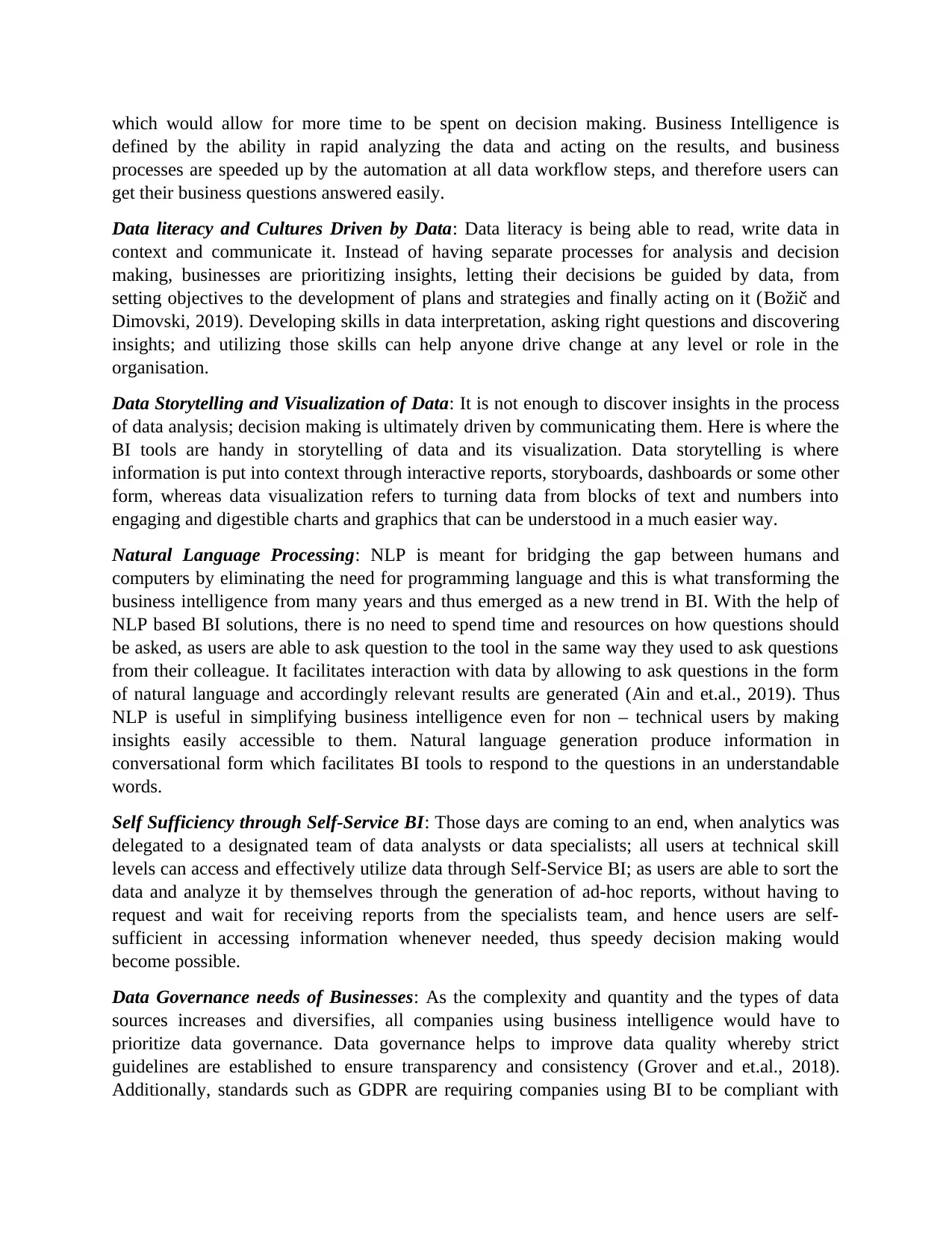
which would allow for more time to be spent on decision making. Business Intelligence is
defined by the ability in rapid analyzing the data and acting on the results, and business
processes are speeded up by the automation at all data workflow steps, and therefore users can
get their business questions answered easily.
Data literacy and Cultures Driven by Data: Data literacy is being able to read, write data in
context and communicate it. Instead of having separate processes for analysis and decision
making, businesses are prioritizing insights, letting their decisions be guided by data, from
setting objectives to the development of plans and strategies and finally acting on it (Božič and
Dimovski, 2019). Developing skills in data interpretation, asking right questions and discovering
insights; and utilizing those skills can help anyone drive change at any level or role in the
organisation.
Data Storytelling and Visualization of Data: It is not enough to discover insights in the process
of data analysis; decision making is ultimately driven by communicating them. Here is where the
BI tools are handy in storytelling of data and its visualization. Data storytelling is where
information is put into context through interactive reports, storyboards, dashboards or some other
form, whereas data visualization refers to turning data from blocks of text and numbers into
engaging and digestible charts and graphics that can be understood in a much easier way.
Natural Language Processing: NLP is meant for bridging the gap between humans and
computers by eliminating the need for programming language and this is what transforming the
business intelligence from many years and thus emerged as a new trend in BI. With the help of
NLP based BI solutions, there is no need to spend time and resources on how questions should
be asked, as users are able to ask question to the tool in the same way they used to ask questions
from their colleague. It facilitates interaction with data by allowing to ask questions in the form
of natural language and accordingly relevant results are generated (Ain and et.al., 2019). Thus
NLP is useful in simplifying business intelligence even for non – technical users by making
insights easily accessible to them. Natural language generation produce information in
conversational form which facilitates BI tools to respond to the questions in an understandable
words.
Self Sufficiency through Self-Service BI: Those days are coming to an end, when analytics was
delegated to a designated team of data analysts or data specialists; all users at technical skill
levels can access and effectively utilize data through Self-Service BI; as users are able to sort the
data and analyze it by themselves through the generation of ad-hoc reports, without having to
request and wait for receiving reports from the specialists team, and hence users are self-
sufficient in accessing information whenever needed, thus speedy decision making would
become possible.
Data Governance needs of Businesses: As the complexity and quantity and the types of data
sources increases and diversifies, all companies using business intelligence would have to
prioritize data governance. Data governance helps to improve data quality whereby strict
guidelines are established to ensure transparency and consistency (Grover and et.al., 2018).
Additionally, standards such as GDPR are requiring companies using BI to be compliant with
defined by the ability in rapid analyzing the data and acting on the results, and business
processes are speeded up by the automation at all data workflow steps, and therefore users can
get their business questions answered easily.
Data literacy and Cultures Driven by Data: Data literacy is being able to read, write data in
context and communicate it. Instead of having separate processes for analysis and decision
making, businesses are prioritizing insights, letting their decisions be guided by data, from
setting objectives to the development of plans and strategies and finally acting on it (Božič and
Dimovski, 2019). Developing skills in data interpretation, asking right questions and discovering
insights; and utilizing those skills can help anyone drive change at any level or role in the
organisation.
Data Storytelling and Visualization of Data: It is not enough to discover insights in the process
of data analysis; decision making is ultimately driven by communicating them. Here is where the
BI tools are handy in storytelling of data and its visualization. Data storytelling is where
information is put into context through interactive reports, storyboards, dashboards or some other
form, whereas data visualization refers to turning data from blocks of text and numbers into
engaging and digestible charts and graphics that can be understood in a much easier way.
Natural Language Processing: NLP is meant for bridging the gap between humans and
computers by eliminating the need for programming language and this is what transforming the
business intelligence from many years and thus emerged as a new trend in BI. With the help of
NLP based BI solutions, there is no need to spend time and resources on how questions should
be asked, as users are able to ask question to the tool in the same way they used to ask questions
from their colleague. It facilitates interaction with data by allowing to ask questions in the form
of natural language and accordingly relevant results are generated (Ain and et.al., 2019). Thus
NLP is useful in simplifying business intelligence even for non – technical users by making
insights easily accessible to them. Natural language generation produce information in
conversational form which facilitates BI tools to respond to the questions in an understandable
words.
Self Sufficiency through Self-Service BI: Those days are coming to an end, when analytics was
delegated to a designated team of data analysts or data specialists; all users at technical skill
levels can access and effectively utilize data through Self-Service BI; as users are able to sort the
data and analyze it by themselves through the generation of ad-hoc reports, without having to
request and wait for receiving reports from the specialists team, and hence users are self-
sufficient in accessing information whenever needed, thus speedy decision making would
become possible.
Data Governance needs of Businesses: As the complexity and quantity and the types of data
sources increases and diversifies, all companies using business intelligence would have to
prioritize data governance. Data governance helps to improve data quality whereby strict
guidelines are established to ensure transparency and consistency (Grover and et.al., 2018).
Additionally, standards such as GDPR are requiring companies using BI to be compliant with
⊘ This is a preview!⊘
Do you want full access?
Subscribe today to unlock all pages.

Trusted by 1+ million students worldwide
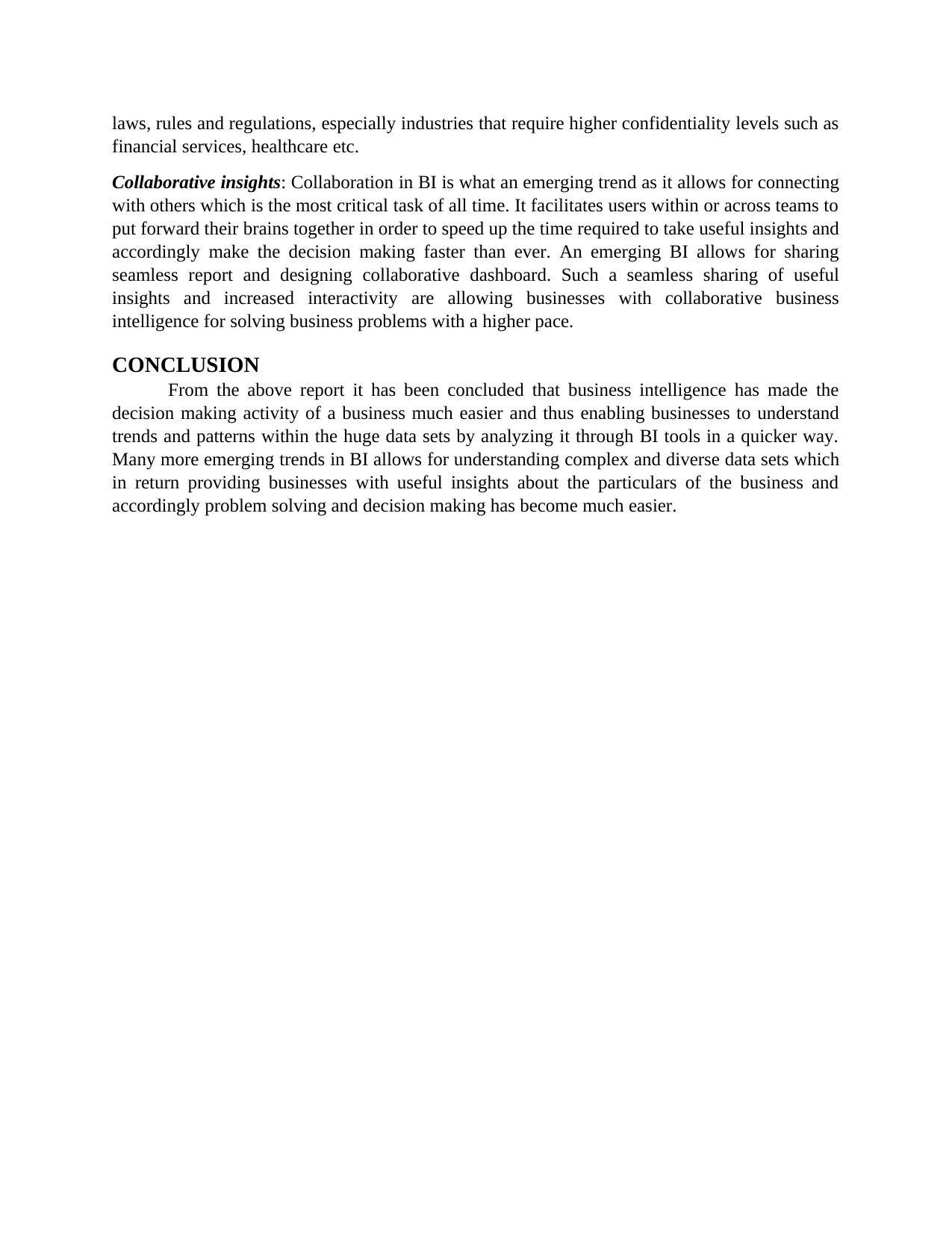
laws, rules and regulations, especially industries that require higher confidentiality levels such as
financial services, healthcare etc.
Collaborative insights: Collaboration in BI is what an emerging trend as it allows for connecting
with others which is the most critical task of all time. It facilitates users within or across teams to
put forward their brains together in order to speed up the time required to take useful insights and
accordingly make the decision making faster than ever. An emerging BI allows for sharing
seamless report and designing collaborative dashboard. Such a seamless sharing of useful
insights and increased interactivity are allowing businesses with collaborative business
intelligence for solving business problems with a higher pace.
CONCLUSION
From the above report it has been concluded that business intelligence has made the
decision making activity of a business much easier and thus enabling businesses to understand
trends and patterns within the huge data sets by analyzing it through BI tools in a quicker way.
Many more emerging trends in BI allows for understanding complex and diverse data sets which
in return providing businesses with useful insights about the particulars of the business and
accordingly problem solving and decision making has become much easier.
financial services, healthcare etc.
Collaborative insights: Collaboration in BI is what an emerging trend as it allows for connecting
with others which is the most critical task of all time. It facilitates users within or across teams to
put forward their brains together in order to speed up the time required to take useful insights and
accordingly make the decision making faster than ever. An emerging BI allows for sharing
seamless report and designing collaborative dashboard. Such a seamless sharing of useful
insights and increased interactivity are allowing businesses with collaborative business
intelligence for solving business problems with a higher pace.
CONCLUSION
From the above report it has been concluded that business intelligence has made the
decision making activity of a business much easier and thus enabling businesses to understand
trends and patterns within the huge data sets by analyzing it through BI tools in a quicker way.
Many more emerging trends in BI allows for understanding complex and diverse data sets which
in return providing businesses with useful insights about the particulars of the business and
accordingly problem solving and decision making has become much easier.
Paraphrase This Document
Need a fresh take? Get an instant paraphrase of this document with our AI Paraphraser
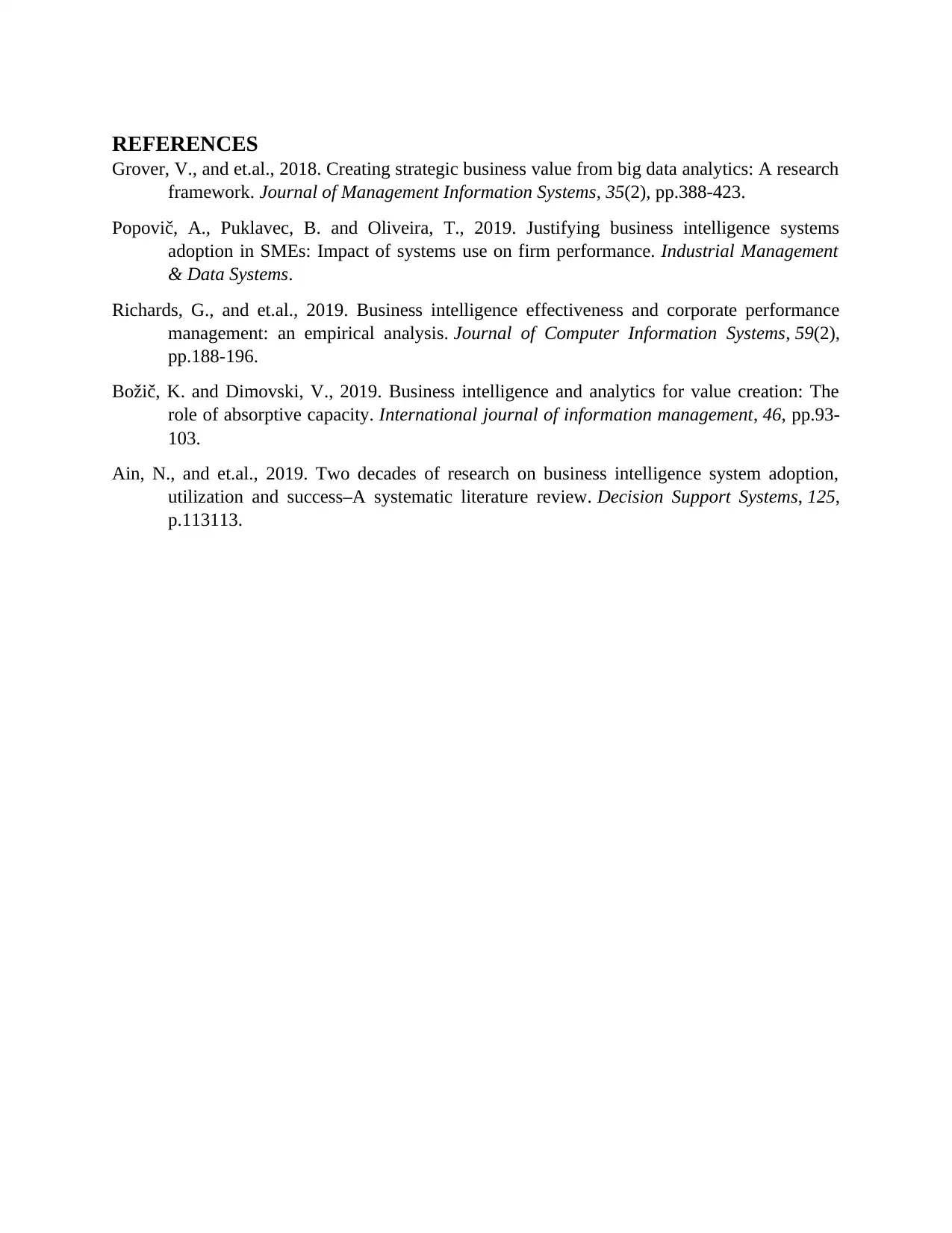
REFERENCES
Grover, V., and et.al., 2018. Creating strategic business value from big data analytics: A research
framework. Journal of Management Information Systems, 35(2), pp.388-423.
Popovič, A., Puklavec, B. and Oliveira, T., 2019. Justifying business intelligence systems
adoption in SMEs: Impact of systems use on firm performance. Industrial Management
& Data Systems.
Richards, G., and et.al., 2019. Business intelligence effectiveness and corporate performance
management: an empirical analysis. Journal of Computer Information Systems, 59(2),
pp.188-196.
Božič, K. and Dimovski, V., 2019. Business intelligence and analytics for value creation: The
role of absorptive capacity. International journal of information management, 46, pp.93-
103.
Ain, N., and et.al., 2019. Two decades of research on business intelligence system adoption,
utilization and success–A systematic literature review. Decision Support Systems, 125,
p.113113.
Grover, V., and et.al., 2018. Creating strategic business value from big data analytics: A research
framework. Journal of Management Information Systems, 35(2), pp.388-423.
Popovič, A., Puklavec, B. and Oliveira, T., 2019. Justifying business intelligence systems
adoption in SMEs: Impact of systems use on firm performance. Industrial Management
& Data Systems.
Richards, G., and et.al., 2019. Business intelligence effectiveness and corporate performance
management: an empirical analysis. Journal of Computer Information Systems, 59(2),
pp.188-196.
Božič, K. and Dimovski, V., 2019. Business intelligence and analytics for value creation: The
role of absorptive capacity. International journal of information management, 46, pp.93-
103.
Ain, N., and et.al., 2019. Two decades of research on business intelligence system adoption,
utilization and success–A systematic literature review. Decision Support Systems, 125,
p.113113.
1 out of 5
Related Documents
Your All-in-One AI-Powered Toolkit for Academic Success.
+13062052269
info@desklib.com
Available 24*7 on WhatsApp / Email
![[object Object]](/_next/static/media/star-bottom.7253800d.svg)
Unlock your academic potential
Copyright © 2020–2025 A2Z Services. All Rights Reserved. Developed and managed by ZUCOL.





